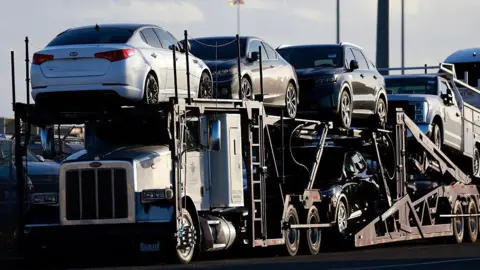On May 3, 2025, a significant legislative shift occurred in the United States as a 25% import tariff on key auto components, including engines and transmissions, was officially implemented. This regulatory change brings renewed challenges to an already complex auto industry landscape, which is grappling with various policy shifts and trade tensions.
This new tariff coincides with a broader trend initiated earlier: a similar 25% tax on imported vehicles was enacted just the previous month. The U.S. administration, under President Donald Trump, has positioned these tariffs as a strategic move aimed at incentivizing automobile manufacturers to enhance their domestic production capabilities within the United States. Despite these intentions, industry analysts caution that this approach may not yield the anticipated results. Instead, any prospective growth in U.S. manufacturing could detrimentally siphon off production from other regions, ultimately contributing to elevated operational costs. These costs, when transmitted to consumers, may lead to higher vehicle prices across the board.
In the immediate aftermath of the tariff implementation, the automotive sector reported an unexpected surge in vehicle sales. Major corporations such as General Motors (GM) and Ford reported robust double-digit sales growth continuing throughout April. However, GM has issued a stark warning about its financial outlook, anticipating an explosion in operational costs, with estimates reaching as high as $5 billion in 2025 due to the tariffs. A substantial portion of these costs is projected to stem from tariffs applied to vehicles manufactured in South Korea and later exported to the United States. Executives at GM have adjusted their pricing expectations, forecasting a 1% increase instead of the previously expected decrease.
The turbulent landscape has led to disarray among automotive companies, with Stellantis—known for producing popular brands like Jeep, Fiat, and Chrysler—restraining its financial forecasts for the upcoming year. In response to market uncertainties, Stellantis’ Chief Financial Officer Doug Ostermann expressed concerns about the extreme unpredictability that remains a defining characteristic of the current automotive environment.
This recent tariff has stirred significant disruptions given that nearly one-half of the vehicles sold in the previous year were imported. The decision from the Trump administration to impose tariffs on both vehicles and certain automotive components sent ripples of concern throughout the industry, provoking fears of inflated prices that could hamper production and sales figures. In particular, the rhetoric surrounding potential tariffs highlighted the fragility of supply chains shaped by the intricate network of previous trade agreements with Canada and Mexico—key partners in this sector.
As a silver lining, it appears that components manufactured in Canada and Mexico adhering to existing free trade agreements will not be subjected to these newly imposed tariffs, providing some respite to companies reliant on cross-border supply chains. This exemption, previously thought to be temporary, looks increasingly likely to become a permanent fixture, following new customs instructions that have emerged.
To address the growing complexities, President Trump has introduced additional measures aimed at mitigating potential burdens on businesses, such as provisions preventing firms from encountering multiple tariffs on identical items. Moreover, a two-year system has been instituted, allowing carmakers to negotiate reductions in tariffs applicable to parts imported from regions beyond North America.
As the industry adapts, efforts to adjust manufacturing strategies are underway. General Motors, for instance, has ramped up truck production at its Fort Wayne, Indiana facility by 50,000 units in direct response to the tariffs while simultaneously curtailing outputs at its Canadian plants. Meanwhile, automakers like Mercedes-Benz are eyeing possibilities to bolster production capabilities at their Alabama manufacturing facility.
Experts predict that these ongoing adjustments will continue as the market navigates through these turbulent conditions. Cornell University’s Labor Studies Director Art Wheaton noted the cautious sentiment prevailing among executives, highlighting the reluctance to invest in new factories amid such volatility. The administration’s engagement with countries such as South Korea and Japan to pursue favorable trade agreements also remains paramount in shaping the trajectory of the industry.
In summation, the 25% tariffs represent a dramatic shift with the potential to significantly reshape the auto manufacturing landscape in the United States. While immediate benefits such as increased sales are observed, the underlying financial pressures and operational uncertainties present profound challenges for the industry’s future viability.



